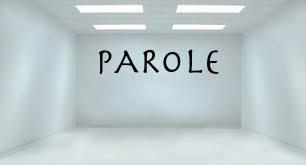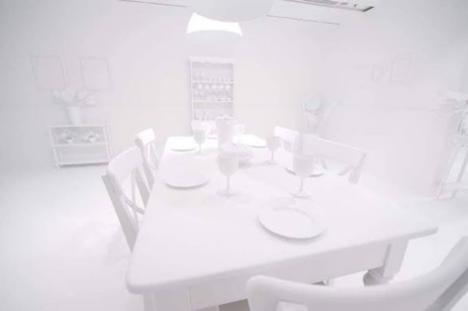Introduction
The film Parole may raise controversy and debate because of its context that portrays transgressive acts. Following the title, the plot revolves around an inmate Randall Keith seeking parole but must undergo an interview and assessment to determine whether he is fit for his request. Set at Leyhill Prison in a US state, the main characters are a parole officer and the inmates. The first part of the script presents the experience of the white male prisoner 1488 in an unusual white room, where he spends a week waiting for a hearing.
Later, during the entire conversation at the hearing, the officer exerts pressure and provokes aggression of 1488. In this way, the parole officer warns that integration into society will be complex and tries to determine if the prisoner has changed to consider giving him parole after long years of incarceration. There is a very strained relationship between the two sides, and much of the conversation between them is hostile, with aggressiveness coming from both of them. Specifically, transgressive acts of violence and racism are portrayed as the two sides accuse each other of such things as oppression and crime.


Identification of the Transgressive Elements in the Film
Violence
Before the parole hearing, prisoner 1488 is imprisoned in a white room, a secluded prison cell, to assess his behavior. The room and objects in it are white or transparent, and attention is attracted by the button, pressing which the prisoner electrocutes himself. Keith uses aggressive language, demanding to know why he is in this room and not at the parole hearing. A parole officer informs the inmate that he will be here for the next seven days to monitor behavior before the parole hearing.
Shocked, inmate 1488 agrees to comply with this requirement, but staying in the room is not easy. Afterward, the audience is taken back to the room a day before the parole hearing. Inmate 1488 starts hallucinating clone of himself, which talk to him and provoke angriness. The clone tells him that Keith should say what he believes in, not what the officers want to hear. This episode reveals a controversial topic about whether prison or other punishment can fix a person’s behavior. The dark hidden side without sufficient resistance can again manifest itself in oncoming difficulties.
At the hearing, cruelty is revealed on new sides and can cause criticism or disapproval of the audience. Parole officer, Afro-Australian Andre Russell, warns the inmate that he will ask questions to get to know Keith better. At the same time, if the prisoner does not want to answer some question, he can press the button, and a girl of color, inmate 420, who is showed the screen, will be electrocuted. As a result, the interview becomes aggressive, provoking, and even violent. The officer asks questions that hurt the inmate, such as views of the other race and feelings towards family members (Fraueky 2016). Russell does everything to provoke the prisoner to show aggression and a tendency to racism. Moreover, the officer manages to find a disturbing topic for Keith – his girlfriend is dating another man, and he is black. Inmate 420 receives a significant volume of shock because of Keith and seems to fall unconscious from the pain.
Thus, the hearing episode is rather cruel, and the audience may doubt the measures presented. The officer’s behavior is close to moral violence, but he justifies himself by the goal of finding out whether the prisoner is worthy of parole. However, the contradiction is where the boundary of permissible measures in finding answers is. Moreover, moral violence on inmate 1488 involves physical one for prisoner 420 – although Keith presses the button, he is provoked. As a result, the question remains whether the prisoner has been able to become better or whether the brutality shown in a problematic situation indicates that the dark side of his personality is still too strong. Moreover, doubts, whether such brutal measures could be indicative may arise.
Racism and Discrimination
The film appears to be offensive, especially regarding matters of race and racism, and discrimination against inmates. First, the inmate himself seems to be highly racist as he uses such words as “nigger”, “blackness,” and “whiteness.” Secondly, he uses such words as “fuck” and “motherfuckers”, which are indeed aggressive as they indicate that rough and obscene language is allowed in the setup. The image of the protagonist is predominantly repulsive; he cannot cope with his own feelings without harming others.
In the same way, the officer is aggressive towards the inmates. For example, Keith experiences a week of psychological torture in the white room, and the torment continues at the hearing. In addition, the system makes inmate 1488 harm inmate 420 through electrocution for own purposes. Such actions reveal abuse of power and discrimination against prisoners as inferior in status. This feature of the episode can be viewed as politically incorrect since, although the prisoners committed a crime and some of their rights are limited, they still need to be protected from abuse (Doogue, 2021). As a result, the resistance test can be seen as an excuse for the shown injustice.
As the film unfolds, the audience realizes that the crime that 1488 committed is aggregated assault against a young black man. The inmate assaulted him after the victim spoke inappropriately about the prisoner’s girlfriend. Notably, the inmate and the girlfriend have a daughter, and the reason he wants to leave the prison on parole is to see them again. For this reason, the news that the girlfriend must have moved on and is now dating a black man are so shocking for 1488 and causes him to hurt inmate 420.
The question of race and illicit bias is well portrayed in the film. In this case, the racial slurs and the treatment of people of the opposite race show that society is still facing racism and discrimination (Scatamburlo-D’Annibale, 2019). For example, the white man assaulted the black man not just because of his girlfriend but also because he was black. He says that the victim dared to insult his girlfriend, yet he was black.
In turn, the parole officer mistreats the inmate to show him that black people also have the power and can use it against the whites. All the questions that the parole officer poses to 1488 seek to determine if he indeed assaulted the victim. However, the inmate insists that he is not a racist, does not hate people of color, and that he did was because of the victim’s aggression towards his partner (Sgorbati 2021). At the end of the script, the African-Australian parole officer draws a conclusion, but it is not revealed.
The attitude towards the victim that the prisoner tried to hide is shown in the hallucinations of the clone, which says, “nigger deserved it.” At the same time, the clone also says that a white prison is a place for such a “white supremacist.” Later, in an interview, 1488 independently identifies himself as a “proud white guy.” These elements in work are other examples of politically incorrect moments that may cause debates. For example, the film has some words that show disrespect to certain members of society. Such words as “nigger,” “proud white man,” and “white supremacist” are disrespectful when considering race issues (Ayim 2018). The word “nigger,” in the film disrespects black people in society. The phrase “proud white man” shows ignorance and lack of respect for society.
As used in modern society, the issue of political correctness attempts to avoid offense and disadvantage to people of different backgrounds. In the same manner, catharsis is used to gain renewal and restoration (Smith and Percy 2019). For instance, inmate 1488 is exposed to torture and the revelation that his partner is dating a black man as a means of changing his attitudes towards the other race and accepting the fact that society has changed. As John Stuart Mills’ harm principle, actions that can be prevented are the same that can create harm (Samuels 2020). In application to the script, this rule means that one can take action as long as it does not harm other people (Graefer 2019). In the film, this principle is presented by the idea of a “proud white man” by inmate 1488. The inmate says that he is a proud white man, but this does not harm others.
Nevertheless, the film does not go beyond the limits of free speech. Instead, it wants to portray the concept of racism in the modern world and implicit bias towards race. The idea is to live in a society where inmates have enough mental resilience such that if pushed to shove, they cannot harm others. People are allowed to feel whether they feel but should not enact those feelings upon others. At the end of the film, prisoner 1488 realizes the feeling deep inside him has been there because of the nature of his society and the influence of the culture and the people around him. Therefore, the work cannot be banned, given that it is primarily educative. However, it may be censored or have age limits for an audience because of the words and scenes involved. For instance, it is not suitable for young people, especially children, because of the lexicon used and aggression.
Conclusion
In conclusion, the film is short but demonstrates that society is still affected by negative prejudices against race and ethnicity. The use of racial slurs such as “white supremacy,” “nigger,” “proud white man,” and others is politically incorrect. The inmates are treated harshly and tortured, contrary to the existing rules and regulations and demonstrating abuse of power. Inmates should always be treated with respect because they are humans. It is evident that the main character in this script committed a crime because he was in a situation that could hardly be avoided. Indeed, he is remorseful and wishes to return to society and assume the roles of a good citizen. However, the interview process is very aggressive and violates the rights of inmates.
Reference List
Ayim, M. (2018) Political correctness: The debate continues. In The Gender Question in Education (pp. 199-214). New York: Routledge.
Doogue, B. (2021). Australia: Prisoner rights and public perception. Web.
Fraueky, J. (2016) C. Wright Mills and the criminological imagination: Prospects for creative inquiry. New York: Routledge.
Graefer, A. (2019) Media and the politics of offence. London: Springer.
Samuels, R., (2020) Catharsis: The politics of enjoyment. In Zizek and the rhetorical unconscious (pp. 7-31). New York: Palgrave Macmillan, Cham.
Scatamburlo-D’Annibale, V. (2019) The ‘culture wars’ reloaded: Trump, anti-political correctness and the right’s’ free speech’ hypocrisy. Journal for Critical Education Policy Studies (JCEPS), 17(1).
Sgorbati, B. (2021) Political correctness and the Law. Undecidabilities and Law, (1), pp.147-160.
Smith, N.L. and Percy, E. J. (2019) Diversity training methods, opinions of political correctness, and perceptions of microaggressions. Psi Chi Journal of Psychological Research, 24.